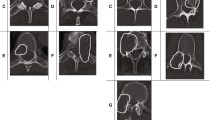Abstract
Purpose
Most spinal metastases are detected late, and thus, the impact of treatment on the health-related quality of life (HRQOL) is an important consideration. This study investigated the HRQOL following surgery for spinal metastases.
Methods
A prospective study of patients operated for symptomatic spinal metastases, at a single tertiary referral spine centre (2011–2013). Data were collected pre-operatively and up to 2 years following surgery (if alive). The HRQOL assessment was performed using recognised systems including the Frankel score (neurological status), EQ-5D, and the Oswestry Disability Index.
Results
A total of 199 patients were studied (median age 65 years, 43% (86) F; 57% (113) M). The Frankel score improved significantly after surgery in 69 patients (35%), worsened in 17 (8%), with 20/39 patients regaining the ability to walk (51%). All the HRQOL scores improved significantly following surgery. The complication rate was 27% and median survival 270 days, and 44 patients (22%) survived at 2 years.
Conclusions
This large prospective study showed that surgical treatment for spinal metastases significantly improved the HRQOL.




Similar content being viewed by others
References
Witham TF et al (2006) Surgery insight: current management of epidural spinal cord compression from metastatic spine disease. Nat Clin Pract Neurol 2(2):87–94 (quiz 116)
Quraishi NA, Gokaslan ZL, Boriani S (2010) The surgical management of metastatic epidural compression of the spinal cord. J Bone Joint Surg Br 92B(8):1054–1060
Quraishi NA, Giannoulis KE, Edwards KL, Boszczyk BM (2012) Management of metastatic sacral tumours. Eur Spine J 21(10):1984–1993
Quraishi NA et al (2013) Effect of timing of surgery on neurological outcome and survival in metastatic spinal cord compression. Eur Spine J 22(6):1383–1388
Laufer I et al (2012) Surgical management of metastatic spinal tumors. Cancer Control 19(2):122–128
Choi D et al (2016) Rapid improvements in pain and quality of life are sustained after surgery for spinal metastases in a large prospective cohort. Br J Neurosurg 30(3):337–344
Tokuhashi Y et al (2005) A revised scoring system for preoperative evaluation of metastatic spine tumor prognosis. Spine (Phila Pa 1976) 30(19):2186–2191
Frankel HL et al (1969) The value of postural reduction in the initial management of closed injuries of the spine with paraplegia and tetraplegia. I. Paraplegia 7(3):179–192
Karnofsky DA et al (1948) The use of the nitrogen mustards in the palliative treatment of carcinoma. With particular reference to bronchogenic carcinoma. Cancer 1(4):634–656
Crooks V et al (1991) The use of the Karnofsky Performance Scale in determining outcomes and risk in geriatric outpatients. J Gerontol 46(4):M139–M144
Funke F, Reips UD (2012) Why semantic differentials in web-based research should be made from Visual Analogue Scales and not from 5-point scales. Field Methods 24(3):310–327
Choi D et al (2013) Assessment of quality of life after surgery for spinal metastases: position statement of the Global Spine Tumour Study Group. World Neurosurg 80(6):16
Fairbank JC, Pynsent PB (1976) The Oswestry Disability Index. Spine 25(22):2940–2952
Turner-Bowker DM, Bartley PJ, Ware JEJ (2002) SF-36 Health survey and “SF” bibliography, 3rd edn. QualityMetric Incorporated, Lincoln
Falicov A et al (2006) Impact of surgical intervention on quality of life in patients with spinal metastases. Spine (Phila Pa 1976) 31(24):2849–2856
Wai EK et al (2003) Quality of life in surgical treatment of metastatic spine disease. Spine (Phila Pa 1976) 28(5):508–512
Pickard AS, Neary MP, Cella D (2007) Estimation of minimally important differences in EQ-5D utility and VAS scores in cancer. Health Qual Life Outcomes 5:70
Hays RD, Morales LS (2001) The RAND-36 measure of health-related quality of life. Ann Med 33(5):350–357
Lee JS et al (2003) Clinically important change in the visual analog scale after adequate pain control. Acad Emerg Med 10(10):1128–1130
Author information
Authors and Affiliations
Corresponding author
Ethics declarations
Conflict of interest
The authors declare that they have no conflict of interest.
Additional information
Publisher's Note
Springer Nature remains neutral with regard to jurisdictional claims in published maps and institutional affiliations.
Rights and permissions
About this article
Cite this article
Quraishi, N.A., Pasku, D., Koch, J.E.J. et al. Prospective analysis of health-related quality of life after surgery for spinal metastases. Eur Spine J 29, 3163–3169 (2020). https://doi.org/10.1007/s00586-020-06396-6
Received:
Accepted:
Published:
Issue Date:
DOI: https://doi.org/10.1007/s00586-020-06396-6




